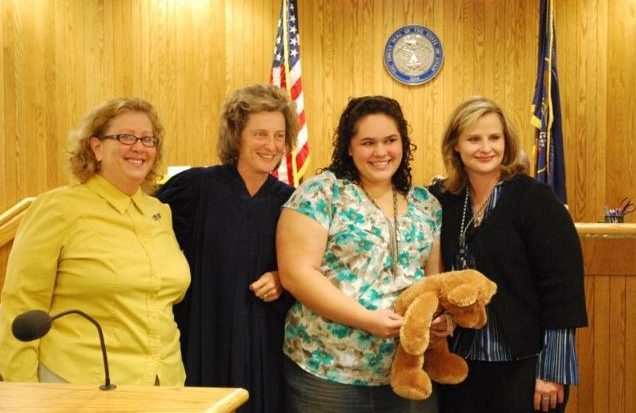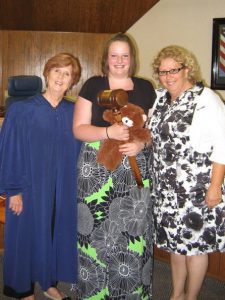
Olive green “man sandals” that matched her truck. Burnt enchiladas as a welcome dinner. A Provo home in need of “an accent wall.”
Sophie Zelenak’s first impressions of foster parent Nancy Zelenak were not great.
Sophie was just one of approximately 2,900 Utah children in foster care at any given time.
Sophie had been in and out of the foster care system since she was 5 years old. After being abused by her biological father and living with three different foster families, Sophie was hesitant to build any kind of relationship — especially one with Nancy.
Nancy said she originally had no intention of fostering or adopting. As a single woman working as a trainer at the Utah Foster Care Center, she was busy and had never been a parent before. However, she said she decided she wanted firsthand experience with fostering so she could better teach the foster parents she was training.
“I was a novice,” Nancy said. “I had no idea what I was getting into. I was working full time. I didn’t know how much energy it took to raise kids — I had no idea — but I have learned very quickly that it takes a lot of energy.”
Sophie said their relationship turned around when she finally accepted Nancy’s nightly goodnight hug.
Sophie said she noticed how Nancy would do little things to give her the childhood Sophie never had. When Nancy found out Sophie had never been read bedtime stories or tucked in as a child, she began to do both. When Nancy offered to adopt Sophie at age 15 in 2010, Sophie accepted.
“I definitely felt like I was drowning in the world of 7 billion people, and I felt like there wasn’t a single person I could relate with who could pull me out of the water I was drowning in,” Sophie said. “Then I met Nancy, and my whole world changed.”
Aubrianna Zelenak was also not interested in a relationship with Nancy when she first came to live with her as a foster child. Aubrianna entered the foster system at age 11 because of an abusive home, and for the majority of her time in the system she had lived in a group home with 17 other people.

Although she loved the friendships she developed there, the children were all temporarily removed from the group home in October 2009 because of an investigation of alleged abuse. Aubrianna and her half sister, Caitlyn, were sent to live with Nancy.
Aubrianna said Nancy’s thoughtfulness helped them grow close, and when the abuse allegations of the group home were confirmed, Nancy offered to adopt Aubrianna. She adopted Aubrianna at age 16 in 2010.
Aubrianna and Sophie said they consider Nancy to be their best friend and appreciate the way she changed their lives and gave them the chance to have dreams and goals.
Aubrianna graduated from high school a year early with honors and is now attending Utah Valley University. She said she attributes her success to Nancy.
“Before her, I had no desire to do anything with my life,” Aubrianna said.
Sophie said Nancy adopted not only them, but also their biological families.
Nancy has reached out to Sophie’s and Aubrianna’s biological families. Aubrianna’s biological mother now comes over for every holiday and Aubrianna said she’s close to Sophie’s siblings.
While their family is not traditional, Sophie said she loves it.
“We put the ‘fun’ in ‘dysfunctional,'” Sophie said.

Nancy said the most challenging part of fostering was the children dealing with the trauma they had experienced.
“All they know what to do is scream at the top of lungs and maybe pull their hair or rip their clothes or thrash around on the ground,” Nancy said. “Watching a kid go through the expression of trauma is almost secondary trauma for the caregiver.”
Nancy has fostered five girls and adopted three of them since 2009. She said while she never planned on adopting, she decided there was nothing holding her back from it but her own selfishness.
According to John Thill, Lead Foster-Adoptive Consultant at Utah Foster Care, the primary goal of foster care is always reunification of the children and their biological parents. When this cannot happen, adoption is the next best choice. Thill has fostered 65 children over the years and has 20 children, 18 of whom are adopted. He said no particular type of family provides a better environment for foster kids.
“Each family is able to bring with them their unique skills and talents to be able to help these kids, and whether they are married with two-parent families, or single and only have one-parent families, they have a lot to offer,” Thill said.
Provo resident Tami Bauer and her husband have five biological children and have fostered five children since November 2015. The foster children have all been short-term placements, sometimes leaving with only a few hours notice. She said while the unpredictability can be challenging, her family decided as long as the child is in the home, they will love them.
Bauer said balancing demands can be difficult.
“There’s a lot of different dynamics that you’re working with,” Bauer said. “You’re working with the state, DCFS (Division of Child and Family Services) and the court systems. You’re dealing with therapists. You’ve got team meetings. You’re working with the biological families, coordinating visits. And then you’re working with a child who has been traumatized in various ways.”
Bauer said setting realistic expectations is helpful when she deals with feelings of inadequacy.
“The way to deal with (feelings of inadequacy) is just recognizing our limits but also remembering, ‘I’m just a normal person doing my best to provide a service,’ and just trust that it’s enough,” Bauer said.
BYU alumna Stacey Collins was 14 when three foster siblings came to live at her home with her biological sister and two parents. Although the older foster children left at the end of the summer, the youngest remained with the family for another two years.
Collins said her relationship with her foster siblings was very different than the one she had with her biological sister.
“When you have foster kids in the home, you have to recognize that it’s not the same as having a typical sibling — even if it’s an adopted sibling — because you don’t know how long they’re going to be there for,” Collins said. “You know that their background is pretty warped, and you know that you serve as an example for them as opposed to just being equals.”
Collins said the hardest part was when the foster children, especially the youngest, left. Collins’ family was interested in adopting the youngest, but another woman offered to adopt both her and her sister and the girl was taken from their home. Collins said it has been difficult to watch someone she loves start to make bad choices since then.
“When she left and then seeing her quickly go downhill, it was hard and it still is hard because she’s not out of the weeds yet,” Collins said. “She’s 19 years old and still making really poor choices.”
Collins said she thought families with biological children would be good for foster children because then the attention is spread out and they can see healthy child-parent bonds. However, she said it is more difficult on the biological children because they can feel like they have lost their parents.
“You have to grow up a little faster, and you don’t have time to rebel or be a brat because there are kids that need a lot more in your household from your parents,” Collins said.

Aubrianna said she preferred being fostered by families without biological children because in her experience, biological children were treated better. Sophie said she also preferred being fostered by families without biological children because she said she felt she had to compete with the other children for the love of their parents.
Nancy said she felt not having biological children of her own made it easier for the girls she fostered.
“It is hard when families have biological children for the new kids coming in to not feel like second fiddle. But they never felt that way in my house because there was no first fiddle,” Nancy said.
Bauer said she requested foster children below age 6 because she did not want to displace the birth order of any of her children and said she felt her children would be more welcoming to a younger child. She said while the needs of her children and foster children are hard to balance, it’s good to remember everyone is human.
“There’s no such thing as a perfect family, or a perfect parent or a perfect child, and I think it helps to keep realistic expectations and not be too hard on ourselves,” Bauer said.




